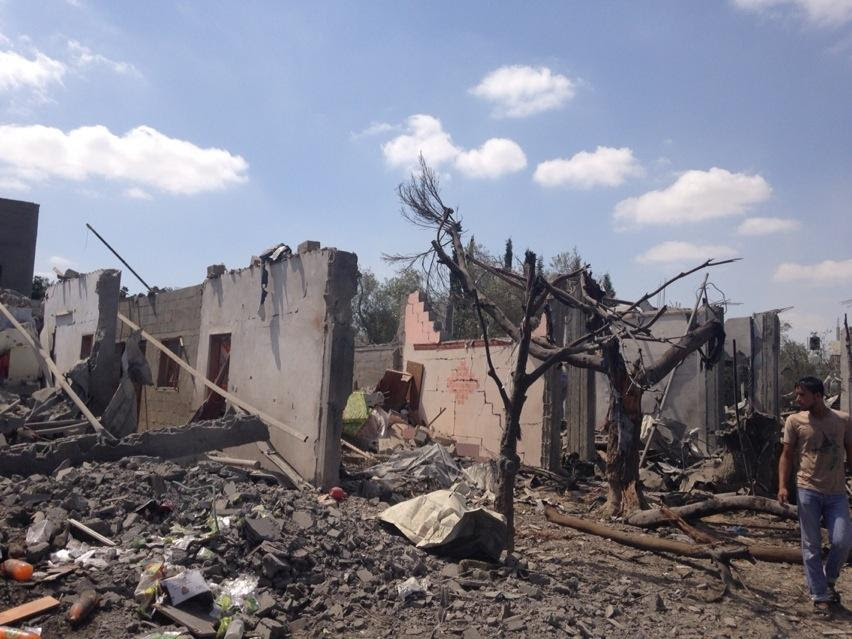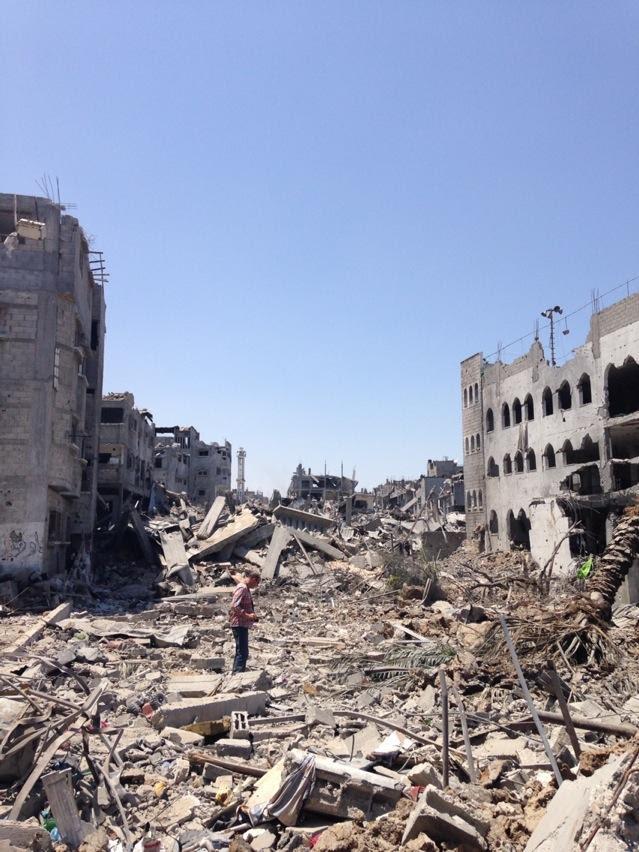.
Depth of Gaza devastation become clear after cease-fire: William Booth, Washington Post, 26 July 2014
Gaza City -- With safe passage promised by a 12-hour humanitarian cease-fire, residents of the areas hardest hit in Gaza fighting returned to their homes Saturday. They could not believe what they saw.
Many roads were barely passable, and almost silent. Women did not wail. The men looked stunned. Their neighborhoods were reduced to ugly piles of gray dust, shattered cement block and twisted rebar.
Huge bomb craters marked the spot where on Friday four-story apartment blocks had stood. On some streets, it seemed as if every house was riddled with bullet holes or shrapnel spray, charred by flames or leveled.
The
scale of the damage from Israeli airstrikes and artillery fire was the
worst seen in the 19 days since Israel launched its offensive. Much of
the damage witnessed Saturday had occurred in the past 24 to 48 hours as diplomats debated the terms of a possible truce.
“It
looks like an earthquake,” said Rafet Sukar, at the front door of his
home on the main street in Shijaiyah, a residential district east of
central Gaza City. The back half of his house was gone.
“It was a miracle we got out of here alive,” said Rami Sukar, his brother.
Blocks of apartments, houses just gone in Shijaiyah. Gaza is just stunned: photo by William Booth via Twitter, 26 July 2014
The
tops of mosque minarets -- perhaps sources of sniper fire -- were blasted
away.
Schools and hospitals were peppered with shrapnel from missiles
and shells that fell within their perimeters.
Water pump stations were blown up, electrical lines toppled onto the streets, the main roads blocked by deep impact craters.
At
the front lines, within sight of the concrete wall that separates the
Gaza Strip from Israel, fresh trails from Israeli tanks and combat
bulldozers snaked through backyard gardens and rolled over greenhouses.
Fires still smoldered as the first reporters and residents reached the towns on the front.
There was no looting, nor any police on the streets.
Ambulances
struggled to reach the dead. Search crews followed bulldozers that
cleared a path forward. There were reports of wounded still trapped in
buildings. The Gaza Health Ministry said its crews had recovered at
least 85 bodies Saturday.
According to the ministry, more than 1,000 Palestinians have been killed in Gaza in the course of the 19-day campaign.
It was obvious that the recovery would take time. In some places, the odor of bodies came so strongly that passersby gagged.
“It
will take more than 12 hours to dig them out,” said Yussif Abid
al-Hamid, an emergency medical technician wearing latex gloves and
trying to get his mask back over his nose. “We need heavy equipment
here. We need earthmovers. We can’t dig with our bare hands.”
Scenes of Beit Hanoun. Whole blocks destroyed, huge bomb craters, minarets hit, fires still burning, bodies: photo by William Booth via Twitter, 26 July 2014
There were many dead animals, too. Donkeys, horses, cows were scattered at the edges of fields and in the marketplaces. The farm towns at the edges of Gaza are where the shepherds live, and in the shelling they were forced to abandon their flocks.
Down one lane, two men carried a cage filled with songbirds. People in Gaza are so desperate that some who came home to gather up belongings left with a few cans of fruit or a half-gallon of cooking oil.
Local reporters and Gaza residents
said the scale of destruction in the areas targeted -- the acres of
bombed housing -- exceeded damage done in the two previous wars of 2009
and 2012. No detailed assessment of the most recent damage was
available.
In
Beit Hanoun in the northern tier of the Gaza Strip -- the scene of
intense street battles between Hamas fighters and Israeli troops -- there
were brass bullet casings and pools of blood and soiled bandages, but
no sign of who had won or lost.
Fighters with Hamas and the other
militant factions were nowhere to be seen, although Israeli military
commanders assumed that the militants would use the 12-hour window to
redeploy men and materiel.
Neighborhoods visited by reporters
just a day earlier were transformed. Mohammad Shawesh returned to his
home in Beit Hanoun on Saturday morning, thinking there might be some
minor damage. It was a wreck. He and his family were picking through the
gutted rooms, and they assembled at the curb a pitiful bag of rice and a
couple of cooking pots.
Family in Beit Hanoun digging out. Collecting a pitiable bag of rice, couple of cooking pots: photo by William Booth via Twitter, 26 July 2014
“I don’t think the truce will last,” he said.
A few hundred yards away, an Israeli tank started up with a cough of brown smoke and began rumbling forward.
House destroyed in Beit Hanoun: lots of downed power lines, dead animals, spent cartridges and last night's tank treads: photo by William Booth via Twitter, 26 July 2014
Zuhair
Hamad had not seen his home in 17 days. It was destroyed. “We came to
get some clothes for the kids,” he said. “The clothes are under there
somewhere.”
A hysterical neighbor shouted at journalists -- “This was an atom bomb!” -- before his friends pulled him away.
Bomb crater in Beit Hanoun: 7 bodies last night. Tanks just down road. People fleeing shouting "the Jews are coming!": photo by William Booth via Twitter, 26 July 2014
At
the end of their block, another Israeli tank turned a corner around a
sandy berm and residents began to run back, shouting, “The Jews are
coming!”
After a few hundred yards, Shijaiyah’s main boulevard
became impassable for vehicles, and so residents walked. The Israeli
military said the district sits on a vast network of underground
bunkers, weapons caches and “terror tunnels.”
“I worked 20 years to make my home, to buy the furniture to put inside,” said Mohammad Helou, a carpenter who had lived in a four-story apartment house with the families of his three brothers.
All that was left was a deep hole in the ground, and a prayer rug they dug up.
William Booth is The Post’s Jerusalem bureau chief. He was previously bureau chief in Mexico, Los Angeles and Miami. He has covered armed conflict in Libya, Iraq, Haiti, and the Balkans.
People including women emerge on streets of Gaza City as 12 hour "humanitarian pause" begins: photo by William Booth via Twitter, 26 July 2014
And before hell mouth; dry plain
and two mountains;
On the one mountain, a running form,
and another
In the turn of the hill; in hard steel
The road like a slow screw’s thread,
The angle almost imperceptible,
so that the circuit seemed hardly to rise;
And the running form, naked, Blake,
Shouting, whirling his arms, the swift limbs,
Howling against the evil,
his eyes rolling,
Whirling like flaming cart-wheels,
and his head held backward to gaze on the evil
As he ran from it,
to be hid by the steel mountain,
And when he showed again from the north side;
his eyes blazing toward hell mouth,
His neck forward,
and like him Peire Cardinal.
And in the west mountain, Il Fiorentino,
Seeing hell in his mirror,
and lo Sordels
Looking on it in his shield;
And Augustine, gazing toward the invisible.

Rotorua Mud Pools, New Zealand: photo by Keith Thome, 5 March 2011
And past them, the criminal
lying in the blue lakes of acid,
The road between the two hills, upward
slowly,
The flames patterned in lacquer, crimen est actio,
The limbo of chopped ice and saw-dust,
And I bathed myself with acid to free myself
of the hell ticks,
Scales, fallen louse eggs.

Erupting Mud Pool, Rotorua, New Zealand: photo by Alan Smith, 29 December 2008
Palux Laerna,
the lake of bodies, aqua morta,
of limbs fluid, and mingled, like fish heaped in a bin,
and here an arm upward, clutching a fragment of marble,
And the embryos, in flux,
new inflow, submerging,
Here an arm upward, trout, submerged by the eels;
and from the bank, the stiff herbage
the dry nobbled path, saw many known, and unknown,
for an instant;
submerging,
The face gone, generation.
Ezra Pound: from Canto XVI, 1923, in A Draft of XXX Cantos (1930)
Waimangu Volcanic Rift Valley, Rotorua, New Zealand: photo by world-wide-gifts, 11 January 2009
Pre-Socratic
There remain lessons to be gained from history
It once more becomes
hard not to see
through the gauze binding
that not only is any given thing
that happens
not nothing, but (remember!) it just may be
Shijaiyah leveled. In this block multiple buildings down. Bombing here would have been unsurvivable: photo by William Booth via Twitter, 26 July 2014

















7 comments:
Bobby Womack: Across 110th Street
Donny Hathaway: The Ghetto (live, 1972)
Looking through the post with K this morning, imagining our street in such ruins. All the kids out playing footie in the road and looking forward to Eid.
We have to have a clear picture of the possibility of hell for ourselves - a moral imperative - so that we can know how close to impossible hope is.
Deuteronomy 5 onwards has full instructions.
love, Tom
Roll the clocks back, brethren.
http://en.wikipedia.org/wiki/Bombing_of_Dresden_in_World_War_II
Deuteronomy's right. This verse came into my head this morning:
But of the cities of these people, which the Lord thy God doth give thee for an inheritance, thou shalt save alive nothing that breatheth.
Every day I come here to read the words and look (as much as I can) at the photographs—most other “news” about Gaza being just a daily whitewashing of this willful, grotesque exercise in death and destruction. To say that we suffer (some of us, anyway) along with the people of Gaza is inadequate, though it's true, and necessary. There’s no consolation in it.
Extremely difficult and isolating time here, so it's consoling to hear the strong voices of friends.
Day of sorrow. More bombing and killing in Gaza. Benjamin Deuteronomy appears on all four major broadcast networks in USA, to deliver the same tired propaganda package, to which everyone watching is of course meant to apply instant unquestioning subscription.
Another view, from somebody who's actually seen some of the horrors Bibi the Hard hath wrought:
Jon Snow: Back from Gaza, 26 July 2014
And meanwhile -- Haaretz, 26 July, on Tel Aviv anti-war protest, disrupted by pro-war demonstrators:
"The ill-will felt towards the Israeli left could be gauged well among the group of right-wing protesters that the police corralled in a separate part of the plaza. They continually shouted 'Death to the leftists' and expressed hope that 'a rocket from Gaza' would kill them. In addition they merrily sang 'Why is there no school in Gaza? Because no more kids are left.' Some protesters tried to convince this group to stop singing these songs as they were detrimental to the message of support for the IDF that they were trying to promote, but to no avail."
Post a Comment